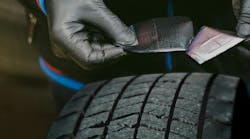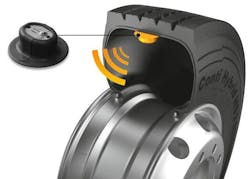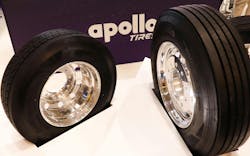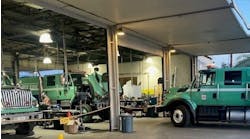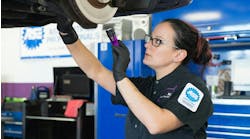This is Part One of a three-part series.
Two percent may not seem like a big number, but that all depends on how big the whole is. The 2023 American Transportation Research Institute’s Analysis of the Operational Costs of Trucking put tire expenses at 2% of a fleet’s per-mile costs, however, carriers who supplied cost data for the report collectively ran more than 13.6 billion miles. The 2022 average cost per mile was $2.25, with tires accounting for 4.5 cents per mile. That means they collectively spent nearly $1.4 billion on tires, and these expenses are climbing. The 2023 ATRI analysis also noted a 9.8% increase in tire costs over 2021.
Tires remain one of a fleet’s highest costs, ranking near the top of operating expenses after fuel and driver wages. And it’s no secret that positive changes to a fleet’s tire management strategy will have a dramatic effect on profitability. Just like stopping an air leak will prevent a flat tire, patching inefficiency holes in your overall tire program will lead to more zeroes in your profit line.
“A properly managed tire program can save thousands or even tens of thousands of dollars annually, depending on the fleet size,” explained Valentino Faraone III, regional vice president, new product development manager, Double Coin.
This starts with addressing the gaping leaks. Choosing tires that exhibit the longest wear and practicing effective preventive maintenance will promote longer life and eliminate failures like blowouts. But some holes could be as narrow as a pin and the air, or in this case, efficiency, still finds a way to escape. Here we cover all the potential areas of waste in a tire program, some you probably know, and some you might not, to help you turn that 2% into an even smaller number.
Pressure points
Let’s start with the obvious. Tires need to be inflated to the proper psi. This affects not only the life of the tire but fuel costs as well.
“Checking air pressure on a regular basis has a positive impact on the life, wear, and performance of tires,” said Jim Garrett, product category manager, Michelin North America. “Fleets may also be taking more of a hit on fuel costs than they realize because of tire pressure losses, especially with today’s high fuel prices.”
Tires are designed for a specific amount of deformation as they roll through the tread contact area, Garrett explained. And because an underinflated tire has more deformation as it rolls, that creates several negative effects.
One of those is because the energy used to deform the tire ultimately comes from the fuel tank.
“A rule of thumb that has been in use for some time says that 10% underinflation will cost about 1% in fuel economy,” Garrett related. “And the energy needs to go somewhere and that is often heat, which is an enemy to tire durability.
“Properly chosen tires are also one of the simplest ways to save costs,” Garrett continued. “Low rolling resistance tires may trade off some mileage, but they more than make up for that in fuel savings. In today’s environment, the fuel savings can be ten times more than the trade-off in miles.”
Faraone noted that tire costs can increase with under and overinflated tires. “A tire that is underinflated by just 10 psi can wear up to 20% faster or more,” he said.
“Additionally, under or overinflation can lead to premature tire failure, and possibly damage the vehicle and even jeopardize the load,” Faraone continued. “Overinflated tires are also more susceptible to impact breaks and irreversible irregular wear.”
Read more: Preserve and conserve: Getting the most out of fleet tires
Faraone also pointed out that tire inflation pressures are especially critical in dual tire assemblies, where one often impacts the other.
“A mismatch of as little as 5 psi can change the tire’s circumference,” he explained. “Because dual tires are bolted together to the wheel-end assembly, they are forced to rotate together. That can create unnecessary drag and put significant strain on the tire with the larger circumference because it is forced to bear more of the load, and can inevitably lead to failures, which can cause damage and be costly.”
Fleets should be well aware of the myriad technology solutions to help drivers and maintenance personnel stay on top of tire health, but just in case you aren’t, check out the sidebar of this article.
Matching up
Even the most well-maintained tire can still set a fleet back if it’s not the right tire for the job. That’s why matching tires to fleet equipment and duty cycles is essential for optimizing performance, safety, and cost-effectiveness, noted Dave Johnston, division head, product & pricing, CV at Apollo Tires.
He said this starts with understanding the specifications and requirements of your fleet’s vehicles and equipment by considering factors such as vehicle weight, axle configuration, load capacity, and intended usage (e.g., long-haul transportation, regional delivery, off-road applications).
A detailed duty cycle analysis should also be conducted. Johnston advised fleets to look at operating conditions (highway, city, off-road), average mileage per trip, frequency of stops and starts, seasonal variations, and terrain characteristics.
Matching tread patterns to the application is important as well, Johnston added.
“Choose tread patterns that are best suited to the specific applications and operating conditions encountered by your fleet,” he said. “For example, select highway tires for long haul transportation, all-terrain tires for mixed on-road and off-road use, and specialized tread designs for severe weather conditions.”
Also, don’t forget what’s ultimately making these tires spin: the powertrain.
“Diesel vehicles typically have higher torque and weight compared to gasoline-powered vehicles,” Johnston said. “As a result, tires for diesel vehicles may need to have a higher load-carrying capacity and be more resistant to wear and tear. Tires for gasoline vehicles may prioritize factors such as fuel efficiency, handling, and comfort. Additionally, electric vehicles often have different weight distributions due to the placement of batteries, and they can generate instant torque at lower speeds, so tires for EVs may need to be engineered to handle the unique demands of electric propulsion systems.”
Matching should continue throughout the life of the tires, as both sides of the axle should seek symmetry as much as possible. Mismatched tread depths in dual tire assemblies can also cause many issues, Faraone noted.
“We recommend no more than a 4/32nd difference between tires mated in a dual assembly for both drive and trailer positions,” he said. “It is also important to make sure tires on each end of the axle have similar depths so that a shifting of the load does not occur, putting unnecessary strain on the tires.”
Proper tire maintenance goes beyond helping ensure maximum tire life. Retreading is a key to tire cost control by improving the return on investment for casing purchases, noted Shaun Uys, vice president, Truck Tires U.S., Continental.
“Effective tire maintenance protects the integrity of the casing, which is critical for retreading,” said Chris Garcia, head of U.S. automotive business, Anyline. “Fleets typically want to get at least two or three retreads out of every tire casing. Extending the amount of time a tire is in service lowers costs by maximizing your tire investment.”
This is Part One of a three-part series. To read more about tire maintenance best practices and tracking, see Part Two when it becomes available.
